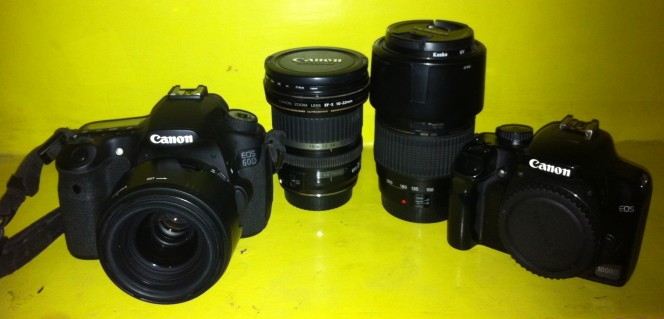One day in the Sikkimese mountains, our camera made its last shot. It came as a shock but was on the other hand not completely unexpected: the EOS 1000D that we had bought a few years earlier finally surrendered to the heat and cold, dust and humidity, salt-water spray and other shocks while bumping around the world. It was a great camera to start out with digital SLR photography and a good travel companion. In Darjeeling there was nobody that could have checked or even repaired any fault so we had to look for a new one if we didn’t want to miss taking pics of the rhinos. I wanted to take this opportunity to pack all the photography nerdiness we accumulated during our travels so far into the following paragraphs, so if you aren’t into SLR, EOS and EFS, just jump to the rhinos we captured with all this kit in Jaldapara National Park.
Since the beginning of our journey we were using a Sigma 18-200mm (f3.5-6.3) superzoom lens as the eye of our EOS 1000. It is a very handy all-purpose zoom lens with good image quality and certainly much better than the plastic lenses that Canon sells as bundles with its bodies. After some estimated 50 000 photos though the aperture belt (a little string of cables inside the lens) in our Sigma had cracked while we were in New Zealand. It took us until Singapore to finally tackle the issue.
After long considerations about our budget, picture quality and the issues of having to change lenses on the road, we decided to replace the Sigma superzoom with two lenses:
A Canon EF-S 10-22mm (f3.5-4.5) ultra-wide angle lens that gives unique perspectives of everything that happens around you and opens up new possibilities for example when you want to capture big buildings in a narrow street. The image quality that it produces is really astonishing and definitely a level up from the superzoom lens we had used before. Thanks to friend and photographer Stephan Labs for recommending us this lens!
However, for the tele shots we would need another lens then. We chose a cheaper option than Canon and picked the Tamron 70-300mm (f4-5.6), a budget lens that even has a macro option to focus on objects as close as 95cm in the 180-300mm range. This is the lens that captured most of the animals, plants and other details for us.
In Hong Kong we had already added an ultrafast Sigma EX 30mm (f1.4) to our gear, which is an fantastic portrait lens and great to shoot in low-light conditions even without flash.
Now what camera body would we use these lenses with our EOS 1000D facing its end? We spent some time with a comparison of the four cheapest Canon models (EOS 1100D, EOS 550D, EOS 600D, EOS 60D – for Canon it is roughly the lower the number the better the camera), so read on if you’re interested in a quick overview. Our old 1000D has been replaced with the EOS 1100D, which now has 12.2 megapixels instead of the former 10.8. The more expensive models though use an even better sensor which besides 18.0 megapixels has also a much better capability for higher ISO speeds, up to 12800. Our 1000D could only go up to 1600 but images taken with ISO 800 would be so grainy already that we regularly felt this was a serious limitation – more so than the number of megapixels.
The 550D is the next more expensive camera, similar in weight and size to the 1100D, but higher resolution. The 600D then has a movable LCD screen and won several awards as best entry-level camera. The even pricier, slightly heavier but also more robust 60D then features the same multi-angle display, full HD video and high resolution. Besides the more durable container, a little screen on top of the camera and a digital level, it was also one other feature that convinced us to go with the 60D: a so called ‚Automatic Lighting Optimizer‘ which measures lighting in 63 different fields of the image and adjusts the sensitivity individually resulting in more balanced photos with fewer too white or too dark areas and hence more detail in the shadows and highlights.
So we did buy a 60D in Siliguri, just in time to shoot some nice wildlife photos in Jaldapara National Park, which after reading all the photography talk you should finally check out as well.




4 Responses to The camera is dead, long live the camera